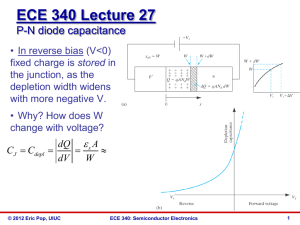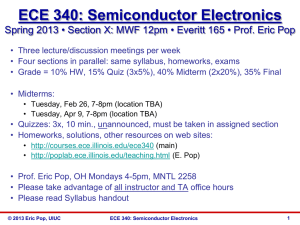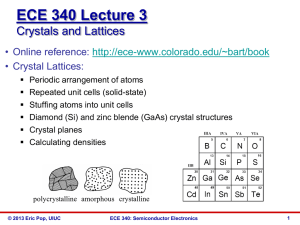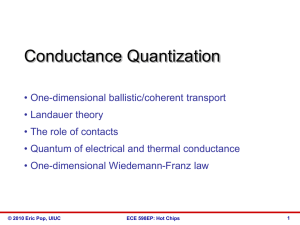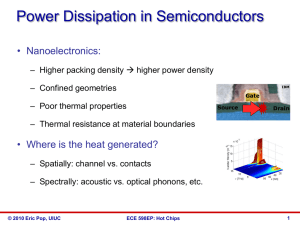L9toL11_CarriersDriftMobility
advertisement
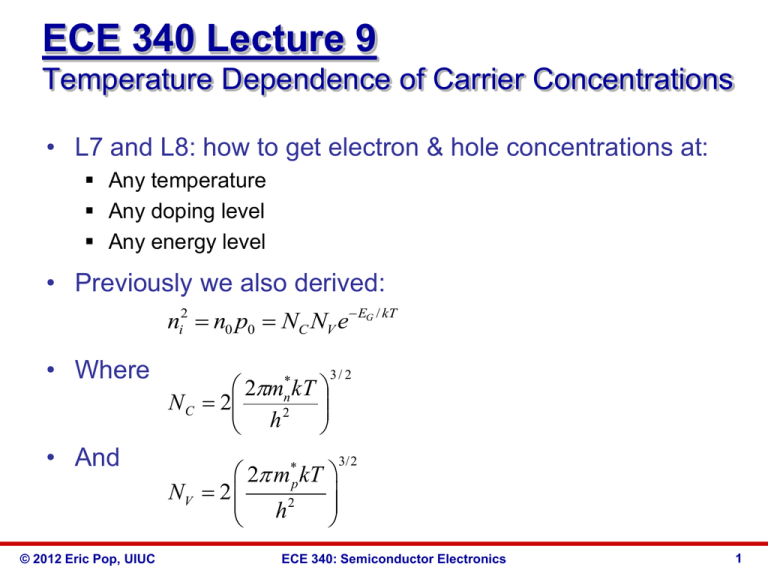
ECE 340 Lecture 9 Temperature Dependence of Carrier Concentrations • L7 and L8: how to get electron & hole concentrations at: Any temperature Any doping level Any energy level • Previously we also derived: ni2 n0 p0 NC NV e EG / kT • Where • And © 2012 Eric Pop, UIUC 2m kT N C 2 h * n 2 2 m*p kT NV 2 h2 3/ 2 3/2 ECE 340: Semiconductor Electronics 1 • So the intrinsic carrier concentration at any T is: • What does this tell us? • Note that mn*=1.1m0 and mp*=0.56m0 • These are ________________________ effective masses in Si, not to be confused with _______________________ • Does the band gap EG change with T? © 2012 Eric Pop, UIUC ECE 340: Semiconductor Electronics 2 • Plot log10 of ni vs. T • What do we expect? • Note your book plots this vs. 1000/T in Fig. 3-17; why? • What is this (simple) plot neglecting? © 2012 Eric Pop, UIUC ECE 340: Semiconductor Electronics 3 • Recall ni is very temperature-sensitive! Ex: in Silicon: While T = 300 330 K (10% increase) ni = ~1010 ~1011 cm-3 (10x increase) • Also note: Now we can calculate the equilibrium electron (n0) and hole (p0) concentrations at any temperature Now we can calculate the Fermi level (EF) position at any temperature • Ex: Calculate and show position of Fermi level in doped Ge (1016 cm-3 n-type) at -15 oC, using previous plot © 2012 Eric Pop, UIUC ECE 340: Semiconductor Electronics 4 • Assume Si sample doped with ND = 1015 cm-3 (n-type) • How does n change with T? (your book plots this vs. 1000/T in Fig. 3-18) • Recall the band diagram, including the donor level. • Note three distinct regions: Low, medium, and high-temperature © 2012 Eric Pop, UIUC ECE 340: Semiconductor Electronics 5 • So far, we assumed material is either just n- or p-doped and life was simple. At most moderate temperatures: n0 ≈ p0 ≈ • What if a piece of Si contains BOTH dopant types? This is called compensation. • Group V elements are _______ and introduce ________ • Group III elements are _______ and introduce ________ © 2012 Eric Pop, UIUC ECE 340: Semiconductor Electronics 6 • Case I, assume we dope with ND > NA Additional electrons and holes will _____________ until you have n0 ≈ ND - NA and p0 ≈ _________ • Case II, what if we introduce ND = NA dopants? The material once again becomes ____________ and n0 ≈ p0 ≈ ______ • Case III and more generally, we must have charge neutrality in the material, i.e. positive charge = negative charge, so p0 + ND = __________ © 2012 Eric Pop, UIUC ECE 340: Semiconductor Electronics 7 • So most generally, what are the carrier concentrations in thermal equilibrium, if we have both donor and acceptor doping? • And how do these simplify if we have ND >> NA (n-type doping dominates)? • When is “>>” approximation OK? © 2012 Eric Pop, UIUC ECE 340: Semiconductor Electronics 8 ECE 340 Lectures 10-11 Carrier drift, Mobility, Resistance • Let’s recap 5-6 major concepts so far: • Memorize a few things, but recognize many. Why? Semiconductors require lots of approximations! • Why all the fuss about the abstract concept of EF? Consider (for example) joining an n-doped piece of Si with a pdoped piece of Ge. How does the band diagram look? © 2012 Eric Pop, UIUC ECE 340: Semiconductor Electronics 9 • So far, we’ve learned effects of temperature and doping on carrier concentrations • But no electric field = not useful = boring materials • The secret life of C-band electrons (or V-band holes): they are essentially free to move around, how? • Instantaneous velocity given by thermal energy: • Scattering time (with what?) is of the order ~ 0.1 ps • So average distance (mean free path) travelled between scattering events L ~ _______ © 2012 Eric Pop, UIUC ECE 340: Semiconductor Electronics 10 • But with no electric field (E=0) total distance travelled is: ___ • So turn ON an electric field: • F = ± qE • F = m*a a = • Between collisions, carriers accelerate along E field: vn(t) = ant = ______________ for electrons vp(t) = apt = ______________ for holes • Recall how to draw this in the energy band picture © 2012 Eric Pop, UIUC ECE 340: Semiconductor Electronics 11 • On average, velocity is randomized again every τC (collision time) • So average velocity in E-field is: v = _____________ • We call the proportionality constant the carrier mobility n, p • This is a very important result!!! (what are the units?) • What are the roles of mn,p and τC? © 2012 Eric Pop, UIUC ECE 340: Semiconductor Electronics 12 • Then for electrons: vn = -μnE • And for holes: vp = μpE • Mobility is a measure of ease of carrier drift in E-field If m↓ “lighter” particle means μ… If τC↑ means longer time between collisions, so μ… • Mobilities of some undoped (intrinsic) semiconductors at room temperature: n (cm2/V·s) p (cm2/V·s) © 2012 Eric Pop, UIUC Si 1400 Ge 3900 GaAs 8500 InAs 30000 470 1900 400 500 ECE 340: Semiconductor Electronics 13 • What does mobility (through τC) depend on? Lattice scattering (host lattice, e.g. Si or Ge vibrations) Ionized impurity (dopant atom) scattering Electron-electron or electron-hole scattering Interface scattering • Which ones depend on temperature? • Qualitative, how? • Strongest scattering, i.e. lowest mobility dominates. 1 © 2012 Eric Pop, UIUC ECE 340: Semiconductor Electronics 14 • Qualitatively • Quantitatively we rely on experimental measurements (calculations are difficult and not usually accurate): http://www.ioffe.rssi.ru/SVA/NSM/Semicond/Si/electric.html © 2012 Eric Pop, UIUC ECE 340: Semiconductor Electronics 15 • Once again, qualitatively we expect the mobility to decrease with total impurities (ND+NA) • Why total impurities and not just ND or NA? (for electrons and holes?) © 2012 Eric Pop, UIUC ECE 340: Semiconductor Electronics 16 • In linear scale, from the ECE 340 course web site: © 2012 Eric Pop, UIUC ECE 340: Semiconductor Electronics 17 • Ex: What is the hole drift velocity at room temperature in silicon, in a field E = 1000 V/cm? What is the average time and distance between collisions? © 2012 Eric Pop, UIUC ECE 340: Semiconductor Electronics 18 • Now we can calculate current flow in realistic devices! • Net velocity of charge particles electric current • Drift current density ∝ ∝ ∝ net carrier drift velocity carrier concentration carrier charge J ndrift qnvdn qnn E J pdrift qpvdp qp p E (charge crossing plane of area A in time t) • First “=“ sign always applies. Second “=“ applies typically at low-fields (<104 V/cm in Si) © 2012 Eric Pop, UIUC ECE 340: Semiconductor Electronics 19 • Check units and signs: • Total drift current: J drift J ndrift J pdrift q(nn p p )E • Has the form of Ohm’s Law! • Current density: • Current: J E E I JA • This is very neat. We derived Ohm’s Law from basic considerations (electrons, holes) in a semiconductor. © 2012 Eric Pop, UIUC ECE 340: Semiconductor Electronics 20 • Resistivity of a semiconductor: 1 1 q(nn p p ) • What about when n >> p? (n-type doped sample) • What about when n << p? (p-type doped sample) • Drift and resistance: L 1 L R wt wt © 2012 Eric Pop, UIUC ECE 340: Semiconductor Electronics 21 • Experimentally, for Si at room T: • This is absolutely essential to show our control over resistivity via doping! • Notes: This plot does not apply to compensated material (with comparable amounts of both n- and p-type doping) This plot applies most accurately at low-field (<104 V/cm) © 2012 Eric Pop, UIUC ECE 340: Semiconductor Electronics 22
